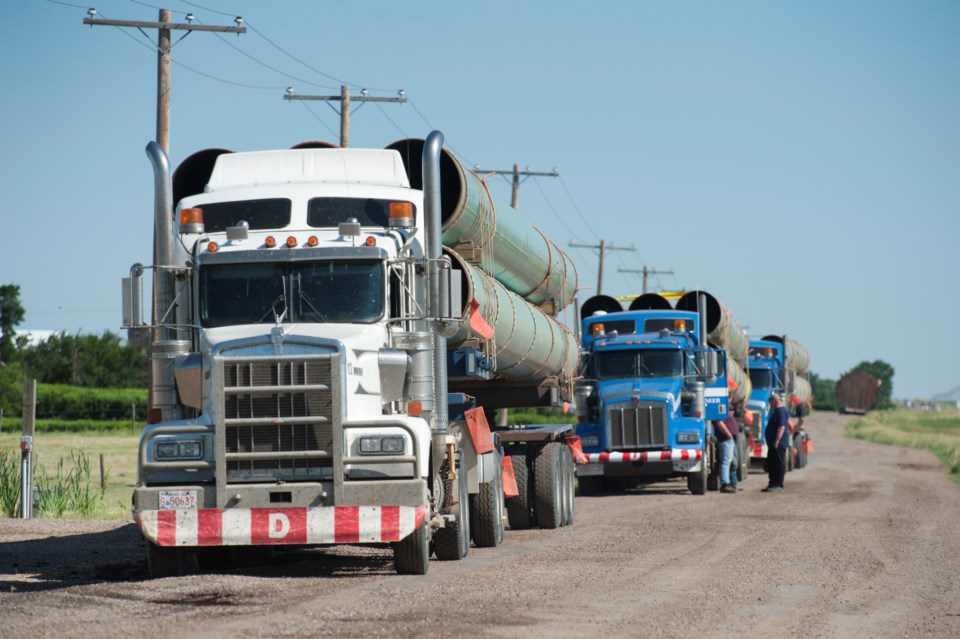Washington – True to his word, newly elected U.S. President Donald Trump approved the TransCanada Keystone XL pipeline, subject to new negotiations. He did it on Jan. 24, his fourth day in office.
Also true to his word, he followed up on his “wanting a piece.” During the Oval Office signing С����Ƶ, Trump said the pipeline been subject to dispute, and “subject to a renegotiation of terms, by us. We’re going to renegotiate some of the terms. And, if they’d like, we’ll see if we can get that pipeline built. A lot of jobs. Twenty-eight thousand jobs. Great construction jobs.”
With that, he signed the executive order, and held it up for cameras to see. The day before, Trump had met with numerous International Unions, including several, such as the United Association and Laborer’s International Union, whose scope includes mainline pipeline construction.
In Bismarck, N.D. on May 26, 2016, Trump responded to a Pipeline News question about the pipeline by saying, “I’m going to say, “Folk’s, we’re going to let you build a pipeline. But give us a piece.”
First proposed in 2008, the Keystone XL pipeline was continuously delayed by the previous Barrack Obama administration until, finally on Nov. 6 2015, Obama denied the necessary Presidential Permit for the project to go ahead. Over these many years the pipeline had become a lightning rod in American politics for the environmental movement. Small portions of the pipeline were rerouted as a result. Congress repeatedly moved to approve the project, only to be blocked by Obama.
In rejecting the pipeline, Obama said, “Now, for years, the Keystone Pipeline has occupied what I, frankly, consider an overinflated role in our political discourse. It became a symbol too often used as a campaign cudgel by both parties rather than a serious policy matter. And all of this obscured the fact that this pipeline would neither be a silver bullet for the economy, as was promised by some, nor the express lane to climate disaster proclaimed by others.”
He also referred to its product as “dirtier oil.”
Obama’s denial of the Presidential Permit was a major victory for the environmental anti-oil lobby. That victory now appears to be reversed.
The Keystone XL Pipeline Project is a proposed 1,897 km, 36-inch-diameter crude oil pipeline, beginning in Hardisty, Alta., and extending south to Steele City, Neb. The project originally ran right to the Texas Gulf Coast, but it was split several years ago and the southern portion has been built and is in operation.
While often overlooked in other media, the up to 15 per cent of the pipeline’s 830,000 bpd capacity is designated for North Dakota-produced Bakken oil, which would join the pipeline at Baker, Mont.
The right-of-way cuts across the very southwest corner of Saskatchewan, running from Burstall, right past Shaunavon and crosses the American border at Monchy.
Canada’s National Energy Board approved construction of the Canadian portion in March 2010.
To provide a Saskatchewan perspective, back in July 2011, TransCanada was stockpiling pipe south of Shaunavon. Premier Brad Wall had twice gone to Washington to lobby for the pipeline’s construction.
Premier Brad Wall, one of Canada’s strongest political advocates for the pipelines, said the following in a statement on Jan. 24:
“We welcome President Trump’s approval of the Keystone XL pipeline. This is a win for both our countries’ energy industries, for energy consumers and for energy security.
“I have said before that if Keystone had been judged on its merits and on the facts – it would have been approved years ago.
“Our government has advocated strongly for Keystone. As the National Post’s Claudia Cattaneo succinctly put it in a column about Keystone, the pipeline ‘meets U.S. criteria, enhances U.S. energy security, feeds Canadian heavy oil to U.S. refineries that want it, is important to Canada’s economy, and is better for the environment than rail.’
“For Canada, it means we can move our oil – safe, secure Canadian oil – to our biggest customer and to tidewater. It will help lower the price differential Canada receives for its oil – that differential costs our governments and producers hundreds of millions of dollars each year. It will also help free up capacity on our railways for moving other products.
“For Saskatchewan, there will be about 2,200 jobs building the 530 kilometres of Keystone XL in Alberta and Saskatchewan at a cost of approximately $1.2 billion. Keystone XL is projected to result in an additional $3.5 million in additional property tax revenues in Alberta per year and $1.3 million in Saskatchewan.
“This is also good news for Evraz in Regina. The company participated in the Keystone project up to the point that it was shut down by the Obama Administration and are optimistic their company will continue to be involved in the project now that it has been approved to go forward,” Wall concluded.
As the approval occurred just before this edition went to press, Pipeline Newswas unable to obtain a response from TransCanada before press time. Additionally, the White House had not yet released the wording of President’ Trump’s executive order.




